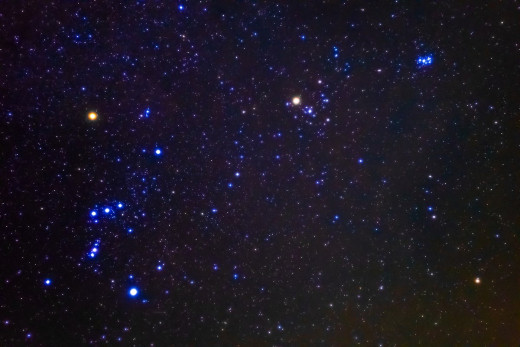Astronomy with Binoculars

Stargazing with Binoculars
You might be surprised to hear that there are many deep space objects, such as galaxies, star clusters, or nebulae, which can be seen with a pair of binoculars. That’s right… Binoculars!
It’s true that just about any old pair of binoculars will enable you to see more stars than you would be able to see with your eyes alone – even that old pair that’s been up in your closet for years.
However, if you are serious about astronomy or stargazing as a hobby, you may want to consider a pair of astronomy binoculars with features that are optimized for viewing the night sky. Astronomical binoculars have features specifically selected for viewing stars and faint deep space objects. Plus you can get a decent pair for under a $100.

Binocular Features to Consider to Enhance Astronomical Viewing
Here’s an explanation and a run-down of the features that you will want to consider in a pair of astronomy binoculars.
Objective Lens
The objective lens is the large lens located on the front of the binoculars. The size is represented as it’s diameter in millimeters.
When it comes to viewing deep space objects, the name of the game is light gathering power – and this is directly related to the size of the objective lens. The larger the diameter of the lens, the more light gathering power the pair of binoculars will have.
While magnification does have a role to play in viewing deep space astronomical objects, it’s not their lack of size that prevents them from being viewed. These objects are so distant, and so dim, that the light from these objects must be ‘amplified’ in order to view them to any significant extent – and that’s the role the objective lens plays. All other features and components in a pair of astronomy binoculars serves in either optimizing or preserving the object lens’s light gathering power, or will make a trade-off in light gathering power to obtain another desired characteristic or condition.
So, how does the object lens ‘amplify’ these ultra-dim lights bouncing around the universe?
If you have ever started a campfire with a magnifying glass, it’s the same principle. The magnifying glass collects sunlight from the whole surface area of the glass and focuses it into small, intense, high energy point of light. But, instead of collecting light from our closest star, the Sun, to ignite kindling, the objective lens of the binoculars collects very faint light from extremely distant stars and objects, for the purpose of ‘amplifying’ their brightness.
Of course, you should never, ever, look at the Sun through a pair of binoculars – it will cause serious damage to your eyes, possibly even blindness.
Magnification
Magnification, sometimes referred to as magnification power, is a measure of how many times larger an object will appear when looking through a set of binoculars. The magnification power is often denoted with an x – such as 10x, which means 10 times magnification. A set of astronomy binoculars with 10x magnification will make an object appear to be 10 times closer than it would be to the unaided eye. For example: an object that is 100 feet away would appear as if it were only 10 feet away, when viewed through a set of binoculars that have a 10x rating.

Up in the objective lens section, it was mentioned that the magnification was somewhat secondary to light gathering power – so what will magnification do for the viewer? It will give more definition and a somewhat closer view of any celestial objects you might be observing.
So what does that mean? Well, for objects such as binary stars or star clusters, the stars will have more separation – so where before you may have only seen a single star, under higher magnification, it may become apparent that you are looking at a binary star system.
Additionally, the benefits of higher magnification will also depend upon what is being looked at, and how distant the object is. Unfortunately, a star that is many hundreds or thousands of light years away will still appear as small point of light – even under magnification ranges far beyond what you can get with a set of astronomical binoculars. However, if you are looking at relatively closer objects, such as the moon, or planets within our own solar system, higher magnification will reveal so much more. Even modest magnification, such a 10x or 20x, will be enough to expose craters on the Moon, the rings of Saturn, or the larger moons of Jupiter.
Just keep in mind that a higher magnification power, for a given objective lens size, will take away some of the light gathering power of the binoculars. This may not be as important for planetary viewing, since planets are generally bright, but for viewing deep space objects, such as star clusters, or galaxies, you will want to preserve as much of the binoculars light gathering power as possible. It’s a trade-off: light gathering power versus magnification.
One more note on magnification: a higher magnification also results in a smaller field of view, which means any that any slight movement of the binoculars will result in exaggerated movement while viewing.
Binocular Numbers, or Specs
Binoculars are often described by their specs, such as 10×50 or 15×70 (read as ten by fifty and fifteen by seventy, respectively). The first number represents the magnification, while the second number is the size of the objective lenses, in millimeters.
Field of View
The field of view is how much of the sky you can see when looking through the binoculars. Typically, the field of view is described as either angular or linear. These are just two different ways of describing the same specification.
Angular field of view is measured in degrees. For an example, the moon occupies about half a degree of angular view – so if your set of binoculars has a angular field of view of 4 degrees, about 8 full moons would fit across the viewable area of your binoculars.
Linear field of view is usually represented as how many feet you can see through the binoculars when looking out at a distance of 1000 yards. Astronomy binoculars are better represented with an angular field of view as the objects being viewed are extremely far away.
But no worries if you only know the linear field of view on your set of binoculars – it can be easily converted to angular field of view by dividing the linear field of view by 52.5. Conversely, angular field of view can be converted to linear field of view at 1000 yards by multiplying 52.5 times the angular field of view.
Something to keep in mind here is that the field of view is related to magnification. Generally, the higher the magnification, the smaller the field of view will be. That means like that a higher magnification, and thus a smaller field of view, will make any slight movements of the binoculars seem exaggerated while viewing.
Prisms and Body Types
Binoculars contain a complex set of prisms which bends and reflects the incoming light in order to make the image appear right side up, instead of inverted like you will see in a telescope. There are two prism types found in binoculars: the Porro prism, and the roof prism.
The prism type will affect the body type of the binoculars. The Porro prism models will have a zig-zagged offset barrel, where the roof prism models will have a straight barrel design.
For astronomical viewing, it’s recommended that Porro prism design is used. While the roof prism makes a sleek-looking, lighter, and more compact set of binoculars, the drawback is that it does not preserve as much of the binoculars light gathering power, which is critical in a pair of astronomy binoculars.
Within the Porro prism design, there are a couple of types commonly used in binoculars: BaK-4 ( barium crown glass ) and BK-7 ( borosilicate glass ). The BaK-4 Porro prism is made of a higher quality glass, which adds a little more cost to the binoculars, but is better suited for astronomical viewing for several reasons. First, and most importantly, the BaK-4 Porro prism allows for less degradation of incoming light. It also gives a sharper, crisper image, particularly around the edges of the image. The BK-7 Porro prism does a pretty good job as well and is the type of prism you will find in many value priced binoculars. However, if cost is not an issue, the BaK-4 Porro Prism will deliver the best viewing.
A simple test to see if your set of binoculars has Bak-4 Porro prisms is to hold the binoculars out at arm’s length while looking through the eye pieces. If the binoculars have BaK-4 Porro prisms, the eyepiece will have a nice round shape. If it has BK-7 Porro prisms, the eyepieces will show a kind of squared off view.
Exit Pupil
The exit pupil is the width of the light beam which exits the binocular’s eyepiece. It is usually measured in millimeters.
The ideal exit pupil size would match the size of your eye’s pupil. If the binocular’s exit pupil is larger than your eye’s pupil, not all of the available light will enter your eye and result in a dimmer view. If the binocular’s exit pupil is smaller than your eye’s pupil, this will result in what is called vignetting, which is a reduction of an images brightness at the periphery.
The eye’s pupil, in low light conditions, is roughly 5 millimeters, to a maximum of about 9 millimeters. The average is around 7 millimeters for a person under the age of 25. However, the average size of the eye’s pupil slowly decreases with age until about the age of 50 when the average pupil size ( in low light conditions ) is about 5 millimeters.
Choosing a Pair of Astronomy Binoculars
So, what is the best type of binoculars to get for astronomical viewing? Well, that depends upon you.
You will definitely want to spend some time studying the various features available – and don’t forget to factor in what your goals and interests are in astronomy. Once you have a better understanding of those features, the pros and cons of those features, your goals, and your budget – you will find making a choice will come a lot easier.
And if you have an old pair in the closet, there's no shame in getting started with those. As previously mentioned, most any set of binoculars will allow you to see much more than you can with the naked eye.








